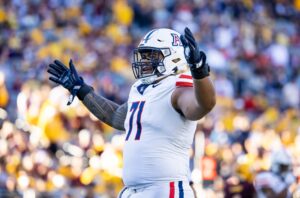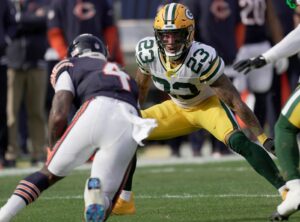The New Orleans Saints are coming off a four-game win streak as they head north to face the 4-2 Baltimore Ravens. A big reason for the Saints best start since 2013 has been the steady improvement of their defense. New Orleans has held their last two opponents under 20 points after surrendering an average of 34.3 points in their first three games.
The Ravens boast a top 12 offense in both points per game (25.5) and yards per game (393.0). However, they’re struggling in other areas and present a favorable matchup for the Saints defense.
Improving New Orleans Saints Defense Should Fare Well Against Baltimore Ravens
Overview
Ball control is perhaps Baltimore’s biggest strength. They rank second in time of possession with an average of 32:39 minutes of possession per game. The Ravens lead the NFL in plays run (465) and first downs (146) while averaging a second-ranked 6.5 plays per drive.
A big reason why they excel in these areas is their efficiency in key situations. Their 46.9 percent conversion rate on third downs ranks third, and they’ve scored on 69.6 percent of their red zone trips, good for fourth-best among NFL offenses.
While the Ravens play efficiently in critical situations, their overall offensive efficiency is among the worst in the NFL.
Baltimore averages a gain of 5.2 yards per play, a full two yards less than the Los Angeles Rams who lead the NFL with 7.2 yards per play. They’re struggling with both pass and run efficiency with the league’s fifth-worst passing average (6.7 yards per attempt) and the second-worst rushing average of 3.4 yards per carry. This bodes well for a Saints defense that’s given up a sixth-worst 6.1 yards per play thus far.
While they’re among the best at third down conversions, Baltimore’s lack of production on early downs has forced them into 96 third down attempts, the second-most among NFL offenses. Even though the Ravens capitalize on red zone opportunities, they score on just 38.2 percent of their drives and average 2.04 points per drive. They rank near the middle of the league in both categories.
Key Matchups
Ravens Offensive Line vs. Saints Front Seven
When a team’s rushing average ranks near the bottom of the league, there are typically multiple factors to blame. On film though, it’s clear that the Ravens linemen are struggling to open holes on run plays. This plays right into the Saints hands since they’re the top-ranked defense in both rushing average allowed (3.1 yards per carry) and rushing yards per game (71.4).
The Saints pass rush is growing more dangerous thanks to the quick development of rookie Marcus Davenport. After failing to record a sack in week one, New Orleans has three sacks in each game since then. The Ravens have been better in pass protection than run blocking though, allowing sacks on just 4.3% of quarterback Joe Flacco‘s pass attempts. This is the league’s seventh-lowest percentage.
Ravens Receivers vs. Saints Secondary
Baltimore quietly built a dynamic receiving corps over the offseason, highlighted by the additions of veteran Michael Crabtree, and former Saint Willie Snead. Crabtree is an excellent route runner with great hands while Snead consistently gets open on short and intermediate routes in the middle. Deep threat John Brown, another offseason addition, is averaging over 20 yards per reception this year.
Cornerback Marshon Lattimore should be ready to go after suffering a concussion in week five. He figures to be a difficult matchup for Crabtree. Keep an eye on P.J. Williams, who has looked good in the slot corner role recently after a disastrous performance as the outside corner against the Atlanta Falcons. Snead is a tough and dangerous matchup from the slot and will present a big challenge for Williams.
Ravens Tight Ends vs. Saints Linebackers
Baltimore also bolstered their tight end group by drafting Hayden Hurst and Mark Andrews, who were two of the top-rated tight ends in the 2018 draft. Tight ends Maxx Williams and Nick Boyle are also heavily involved in the passing game. None of these four have had huge games this season, but they provide reliable check down options for Flacco. Williams, in particular, has caught all 14 of his targets this season.
This deep tight end group is an important part of Baltimore’s schematic approach. They frequently use multiple tight end sets, and have even lined up all four tight ends at the same time. This causes uncertainty for opposing defenses since two or more tight end formations are effective for run plays, yet all four tight ends are capable receivers.
This game will be a big test for the Saints linebackers in coverage, and we might see more 4-3 base formations from New Orleans to better handle the Ravens big formations. Alternatively, the Saints may use more big nickel formations, which include an extra safety rather than a cornerback.
Outlook
The Ravens lack the big play threat that’s caused New Orleans so much trouble this year, so the key for New Orleans will be preventing long drives from Baltimore. This will require the Saints to be stout in third down situations, where they’ve struggled with consistency.
New Orleans ranks 22nd among defenses in this area, allowing conversions on 42.4 percent of opponents attempts. However, they held the Washington Redskins to four conversions on 13 attempts last week and held their week two and three opponents to a combined 8 conversions on 23 attempts.
One benefit, of course, will be the Saints thriving offense. As long as the Saints defense doesn’t completely collapse, their offense should outscore the Ravens. New Orleans has scored 27 more points than Baltimore despite playing one less game thus far, though the Ravens have historically been a challenge for the Drew Brees-led Saints.
Baltimore is the only NFL team Brees has yet to beat, with the Saints going 0-3 against the Ravens since 2006. It certainly won’t be any easier for Brees and the offense to overcome Baltimore this time around. Baltimore currently boasts the league’s top-ranked defense in both points and yards allowed per game.
If Baltimore slows down the Saints offense, it’ll be a great opportunity for their defense to step up and shut down a Ravens offense that lacks firepower.
Main photo:
Embed from Getty Images






